Introducción
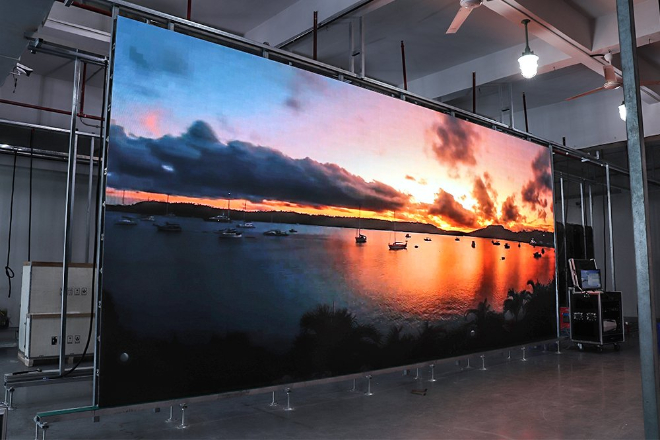
Ya sea una plaza comercial bulliciosa, una sala de conferencias tranquila o un lugar animado, escenarioLa pantalla LED atrae la atención de la gente con su encanto único.
Pero ¿alguna vez has pensado si el tamaño de la Pantalla LED ¿Se puede elegir libremente? ¿Qué factores hay que considerar para elegir la talla correcta? Este artículo responderá a estas preguntas una por una.
Tabla de contenido
1. Una breve introducción al tamaño de la pantalla LED
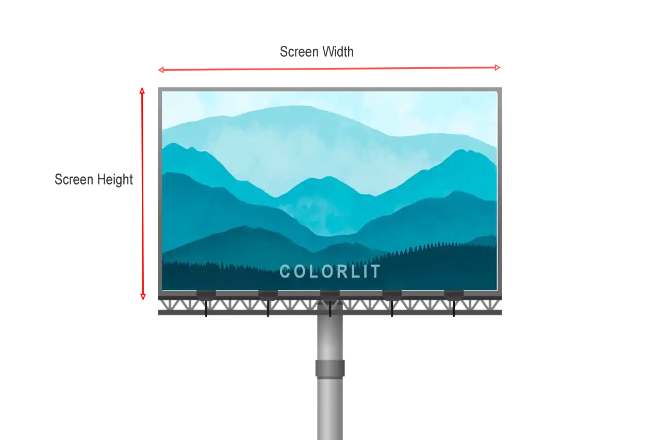
1) Tamaño de la pantalla LED
El tamaño de una pantalla LED, en términos simples, se refiere al tamaño de su "cabeza". Generalmente se expresa en ancho, alto y diagonal.
1.1) Ancho y alto:
Se refiere al largo y ancho de la pantalla, como el largo y ancho de una hoja de papel. Por ejemplo, si una pantalla mide 3 metros de ancho y 2 metros de alto, su área de visualización es de 6 metros cuadrados.
Cuanto mayor sea el área, más contenido se puede mostrar, lo que es adecuado para lugares grandes, como pantallas publicitarias en plazas.
1.2) Longitud diagonal:
Es la distancia desde una esquina de la pantalla hasta la otra esquina de la esquina opuesta.
Esta longitud permite comparar rápidamente el tamaño de la pantalla. Por ejemplo, una pantalla de 3 metros de ancho y 2 metros de alto tiene una diagonal de aproximadamente 3,61 metros.
Sin embargo, no basta con mirar la longitud diagonal, ya que el área de visualización de la misma longitud diagonal puede ser diferente para diferentes relaciones de aspecto.
2) Parámetros relacionados con el tamaño
2.1). Tamaño de píxel
El paso de píxeles es la distancia entre dos pequeños puntos (píxeles) en la pantalla, medida en milímetros. Cuanto menor sea esta distancia, más delicada se verá la pantalla.
Por ejemplo, las pantallas de interior tienen una distancia entre píxeles pequeña (como P1.2 – P3) y la imagen es muy clara cuando se ve desde una distancia cercana.
En el caso de las pantallas exteriores, dado que se ven desde una gran distancia, el tamaño de los píxeles puede ser mayor (por ejemplo, P5 a P10), lo que también implica un bajo coste.
Si el tamaño de los píxeles es demasiado grande, verás pequeños cuadrados cuando mires de cerca y la imagen será incómoda.
2.2). Resolución
La resolución es el número de píxeles que se pueden mostrar en la pantalla, expresado como “píxeles horizontales × píxeles verticales”.
Por ejemplo, 1920×1080 significa que hay 1920 píxeles en la dirección horizontal y 1080 píxeles en la dirección vertical. Cuanto mayor sea la resolución, más nítida será la imagen y más ricos los detalles.
La resolución está relacionada con la distancia entre píxeles y el tamaño de la pantalla. En un mismo tamaño, cuanto menor sea la distancia entre píxeles, mayor será la resolución.
Por ejemplo, para una pantalla de 3 metros de ancho y 2 metros de alto, si el paso de píxeles es P5, la resolución es de aproximadamente 600×400; si el paso de píxeles es P2.5, la resolución puede alcanzar 1200×800.
Las pantallas de alta resolución son adecuadas para mostrar imágenes y vídeos de alta definición, y las imágenes son más delicadas.
2. Factores que afectan la selección del tamaño de la pantalla LED
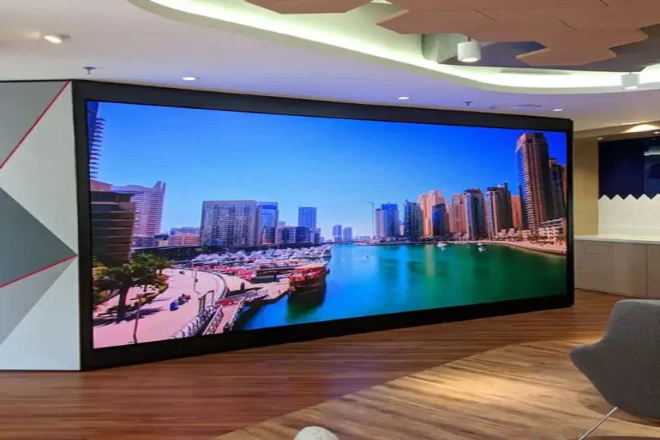
1) Escenarios de aplicación y limitaciones de espacio
1.1) Utilice diferentes tamaños de pantalla en diferentes lugares.
- Pantalla de publicidad exterior:
Imagina que ves una enorme pantalla publicitaria a lo lejos en la carretera. ¿Es muy llamativa?
Este tipo de pantalla suele ser muy grande, de más de diez metros de ancho, para que la gente a distancia pueda verla. Es como colgar un gran cartel en un rascacielos. ¡Cuanto más grande, más llamativo!
- Pantalla de sala de conferencias interior:
La sala de conferencias es pequeña y la gente está cerca de la pantalla, por lo que no es necesario que la pantalla sea demasiado grande.
Por ejemplo, en una sala de conferencias normal, una pantalla de 2 a 3 metros de ancho y 1 a 2 metros de alto es suficiente. Una pantalla demasiado grande resultará abrupta.
- Pantalla del escenario:
El tamaño de la pantalla del escenario depende de lo grande que sea el escenario y de lo lejos que se encuentre el público.
Si se trata de un gran concierto, la pantalla del escenario puede tener que cubrir todo el fondo del escenario, con un ancho de unos 10 metros y una altura de varios metros, para que todo el público pueda ver claramente la actuación en el escenario.
1.2) Espacio insuficiente. La pantalla no puede ser demasiado grande.
Antes de instalar la pantalla, debe medir el espacio. Por ejemplo, si la pared de su tienda tiene solo 2 metros de ancho, el ancho de la pantalla no debe exceder los 2 metros.
De lo contrario, no cabrá. Si el espacio lo permite, la pantalla puede ser un poco más grande, pero si no hay suficiente espacio, puedes elegir una pantalla más pequeña o juntar varias pantallas pequeñas.
2). Distancia de visualización y efecto visual
2.1) La distancia afecta el tamaño y la claridad de la pantalla.
La distancia de visualización es fundamental. Cuanto más lejos estén las personas de la pantalla, mayor será el tamaño de la misma y, por lo tanto, mayor será el espaciado entre píxeles.
Por ejemplo, en las pantallas de publicidad exterior, la audiencia está lejos, el tamaño de los píxeles puede ser mayor (como P10-P20) y la pantalla puede ser grande.
Pero si está en una sala de conferencias en interiores, la audiencia está muy cerca, la pantalla debe ser más pequeña y el tamaño de los píxeles debe ser menor (como P1.2-P3); de lo contrario, se verá muy "granulado".
2.2) Tamaño de pantalla adecuado para diferentes distancias
Distancia corta (3-5 metros): por ejemplo, en una sala de conferencias, el ancho de la pantalla es de 2-3 metros, la altura es de 1-1,5 metros y el paso de píxeles es de P1,5-P2, para que la audiencia pueda ver el texto y los detalles en la pantalla con claridad.
Distancia media (5-10 metros): por ejemplo, en un escenario pequeño, el ancho de la pantalla es de 3 a 5 metros, la altura es de 2 a 3 metros y el paso de píxeles es P2-P3 para que el público también pueda ver con claridad.
Larga distancia (más de 10 metros): por ejemplo, una pantalla publicitaria exterior, el ancho de la pantalla es de más de 5 metros, la altura es de más de 3 metros y el paso de píxeles es P3-P10, que se ve bastante clara desde la distancia.
3) Restricciones presupuestarias
3.1) Cuanto más grande la pantalla, mayor el precio.
El precio y el tamaño de las pantallas LED son muy similares. Cuanto más grande sea la pantalla, mayor será el precio. Al igual que cuando compras algo, cuantas más piezas compres, más caro será.
3.2) Cómo elegir una opción rentable con un presupuesto limitado
Si el presupuesto no es mucho, pero es necesario colocar la pantalla lejos para poder verla, puedes elegir una pantalla con un mayor tamaño de píxeles, como la P5, para que el precio sea menor.
Por ejemplo, si el presupuesto es de solo decenas de miles de yuanes, pero desea hacer una pantalla publicitaria al aire libre, elija un paso de píxeles P5, de 5 metros de ancho y 3 metros de alto, que pueda satisfacer las necesidades y no exceda el presupuesto.
4) Requisitos de visualización de contenido
4.1) Contenido complejo, pantalla grande
Si desea mostrar vídeos de alta definición, imágenes complejas o mucho texto, la pantalla debe ser grande y tener una alta resolución.
Por ejemplo, para publicidad, para mostrar videos de productos en alta definición, la pantalla debe ser grande y la resolución debe ser alta para que la audiencia pueda ver los detalles con claridad.
Pero si solo desea mostrar algunas palabras, como "actividades promocionales", no importa si la pantalla es más pequeña y la resolución es menor.
Lo mismo ocurre con la visualización de información importante. Por ejemplo, en un centro de control de tráfico, la pantalla debe ser grande y de alta resolución para que todos puedan ver claramente el estado de la carretera.
Pero si lo que quieres es mostrar “Oferta de hoy” en la entrada de un centro comercial, una pantalla pequeña es suficiente.
3. ¿Qué tan personalizable es el tamaño de la pantalla LED?
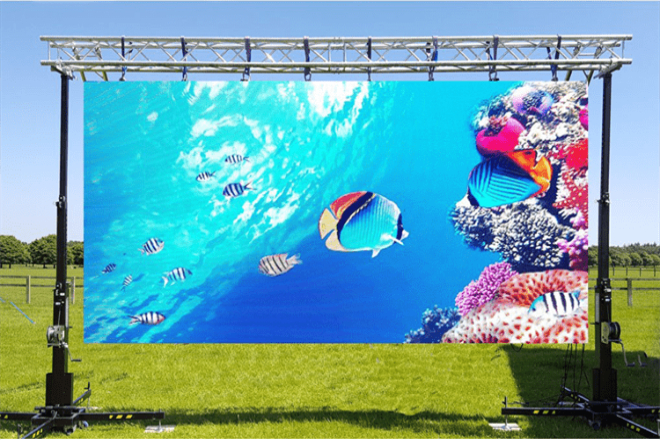
La personalización de la pantalla LED es realmente bastante alta, porque es un producto muy flexible.
Mientras puedas imaginarlo, básicamente puedes hacerlo, por supuesto, la premisa es que sea técnicamente factible y el presupuesto sea suficiente.
1) Ventajas del tamaño personalizado
1.1) Puede satisfacer necesidades especiales
Por ejemplo, algunos lugares requieren pantallas con formas especiales, como redondas, triangulares o irregulares. En estos casos, personalizar el tamaño es muy útil.
Por ejemplo, si hay una columna redonda en el centro comercial y desea instalar una pantalla para mostrar anuncios, puede personalizar una pantalla LED redonda que se adapte perfectamente a la forma de la columna.
También existen algunas instalaciones artísticas o exhibiciones creativas que requieren que la pantalla se integre con el diseño general. Las pantallas de tamaño personalizado satisfacen esta necesidad a la perfección.
Por ejemplo, diseñar una pantalla en la pared exterior de un edificio que sea coherente con el estilo arquitectónico, haciendo que la pantalla sea parte del edificio.
1.2) Uso más razonable del espacio
Se pueden diseñar pantallas personalizadas de acuerdo al espacio real sin desperdiciar espacio ni lucir abruptas.
Por ejemplo, en un espacio largo y estrecho, puedes personalizar una pantalla de tiras largas para aprovechar al máximo el espacio en lugar de forzar una pantalla de tamaño estándar, que se ve muy inconsistente.
2) Desafíos del tamaño personalizado
2.1) Alto costo
El costo de las pantallas personalizadas es mucho mayor que el de las de tamaño estándar, ya que la personalización implica un diseño y una producción separados, e incluso puede requerir moldes especiales.
Por ejemplo, al diseñar una pantalla con una forma especial, el diseñador tiene que dedicar más tiempo a diseñar la forma y también a considerar la estructura y el método de instalación de la pantalla, todo lo cual requiere costos adicionales.
El proceso de producción también es complejo. Las pantallas de tamaño estándar se fabrican en masa y son relativamente económicas.
Sin embargo, las pantallas personalizadas se producen individualmente y los costos de adquisición de materia prima, procesamiento y otros vínculos aumentarán.
2.2) Ciclo largo
Las pantallas personalizadas requieren más tiempo en cada etapa, desde el diseño hasta la producción y la instalación. Por ejemplo, en la etapa de diseño, pueden ser necesarias repetidas modificaciones para cumplir con los requisitos del cliente.
En la etapa de producción, debido a que se produce individualmente, puede llevar mucho tiempo completarlo; en la etapa de instalación, también puede llevar más tiempo debido a la forma compleja de la pantalla.
Si el cronograma del proyecto es ajustado, las pantallas personalizadas pueden resultar un fastidio.
2.3) Alta dificultad técnica
Las pantallas personalizadas requieren soporte técnico profesional. Por ejemplo, la producción de pantallas con formas especiales requiere equipos y procesos de corte especiales; de lo contrario, no se puede fabricar la pantalla con la forma deseada.
La instalación también es muy particular. Por ejemplo, al instalar una pantalla en una pared exterior curva, es necesario considerar el método de fijación y el ángulo de la pantalla; de lo contrario, la pantalla podría quedar inestable o la imagen podría no ser buena.
Además, el servicio posventa de las pantallas personalizadas también es fundamental. Debido a su forma especial, si se produce una avería, la reparación puede ser más compleja que la de una pantalla estándar, por lo que se requieren técnicos profesionales.
En general, el grado de personalización de las pantallas LED es muy alto, lo que permite satisfacer diversas necesidades específicas, pero también presenta numerosos desafíos. Si el presupuesto es suficiente y se dispone de tiempo suficiente.
Si existen requisitos especiales en cuanto a la forma y la función de la pantalla, las pantallas personalizadas son una buena opción. Sin embargo, si el presupuesto es limitado o el proyecto es urgente, quizás deba considerar pantallas de tamaño estándar.
4. Cómo elegir el tamaño de las pantallas LED de forma científica y razonable
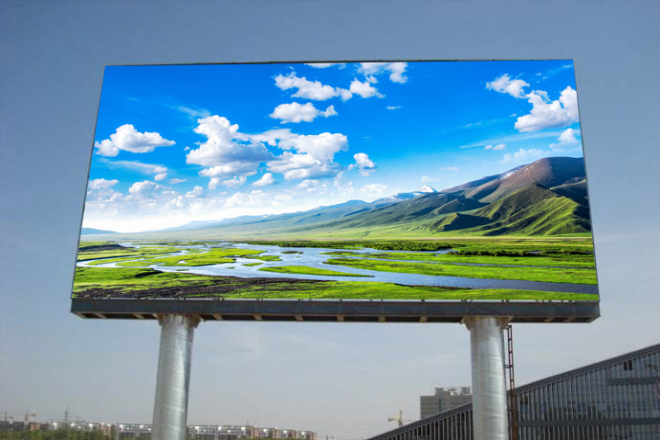
1) Aclarar necesidades y objetivos
Antes de elegir el tamaño de las pantallas LED, primero debes decidir qué quieres hacer. Es como hacer una lista antes de comprar algo; de lo contrario, es fácil equivocarse.
1.1) Escenario de aplicación:
Piensa primero dónde se colocará la pantalla. ¿Será una valla publicitaria en el exterior o se colocará en una sala de conferencias para reuniones? Cada lugar tiene requisitos de tamaño de pantalla diferentes.
Por ejemplo, las pantallas de publicidad exterior deben ser más grandes para que la gente que está lejos pueda verlas; la pantalla de la sala de conferencias no necesita ser tan grande porque la gente está cerca.
1.2) Presupuesto:
El dinero también es importante. Si tienes un presupuesto limitado, no pienses en comprar una pantalla enorme, ya que podría exceder tu presupuesto. Puedes elegir un tamaño que te convenga según tu situación financiera.
1.3) Distancia de visualización:
Piensa en la distancia entre el público y la pantalla. Si el público está lejos, la pantalla puede ser más grande y la distancia entre píxeles puede ser mayor.
Si la audiencia está muy cerca, la pantalla debe ser más pequeña y el tamaño de los píxeles debe ser menor; de lo contrario, se verá muy "granulado".
1.4) Visualización del contenido:
El contenido que se mostrará también es crucial. Si se trata de un video de alta definición o imágenes complejas, el tamaño y la resolución de la pantalla deben ser mayores; si se trata de un mensaje de texto simple, una pantalla más pequeña es suficiente.
2) Consultar asesoramiento profesional.
No basta con averiguarlo por tu cuenta. Debes consultar con proveedores o técnicos profesionales de pantallas LED. Tienen una larga trayectoria y amplia experiencia en el sector. Pueden ofrecerte muchas sugerencias útiles.
2.1) Experiencia del proveedor:
Los proveedores profesionales han visto diversos proyectos y pueden recomendar el tamaño de pantalla adecuado según sus necesidades.
Por ejemplo, pueden decirle que un determinado tamaño de pantalla es el más adecuado según su escenario de aplicación y su presupuesto.
2.2) Conocimientos profesionales de los técnicos:
Los técnicos pueden ayudarle a resolver problemas técnicos. Por ejemplo, si necesita una pantalla con una forma especial, pueden informarle si es técnicamente factible, así como el coste y la dificultad de conseguirla.
3) Evaluación integral y compensación
Por último, es necesario considerar varios factores exhaustivamente para poder elegir la pantalla más adecuada.
3.1) Costo:
Aunque cuanto más grande sea la pantalla y más funciones, mejor, también debes considerar el costo. Si tu presupuesto es limitado, no te apresures a comprar un tamaño grande y una alta resolución.
Por ejemplo, para una sala de conferencias pequeña, una pantalla de 2 a 3 metros de ancho y 1 a 2 metros de alto es suficiente. No es necesario gastar mucho dinero en una pantalla extragrande.
3.2) Viabilidad técnica:
Algunos tamaños o formas de pantalla pueden ser difíciles de lograr técnicamente o el costo de implementación es muy alto.
Por ejemplo, desea fabricar una pantalla con una forma especial y particularmente compleja, pero quizá no sea técnicamente posible o el precio sea demasiado elevado.
En este momento, debe considerar la viabilidad técnica y elegir una solución que pueda satisfacer las necesidades y ser técnicamente factible.
3.3) Condiciones de instalación:
También debe considerar si el lugar de instalación es adecuado. Por ejemplo, si el espacio en la entrada de su tienda es muy pequeño, no considere instalar una pantalla extragrande; de lo contrario, no cabrá.
O bien, si el lugar de instalación tiene una capacidad de carga limitada, no se puede instalar una pantalla demasiado grande. De lo contrario, se producirán riesgos de seguridad.
En resumen, elegir el tamaño de una pantalla LED es como elegir ropa. Depende de la ocasión, el presupuesto y la complexión física. También hay que escuchar las opiniones de los demás y, finalmente, elegir la que mejor se adapte a uno.
5. Conclusión
A través de la introducción de este artículo, creo que tendrá una comprensión más clara sobre la elección del tamaño de la pantalla LED.
BIBLADO Admite tamaños personalizados para cualquier pantalla LED. El tiempo de personalización de cada producto es de aproximadamente 15 a 20 días hábiles (el tiempo específico depende de los datos del proyecto).
Finalmente, si quieres saber más sobre las pantallas LED, Por favor póngase en contacto con nosotros.
